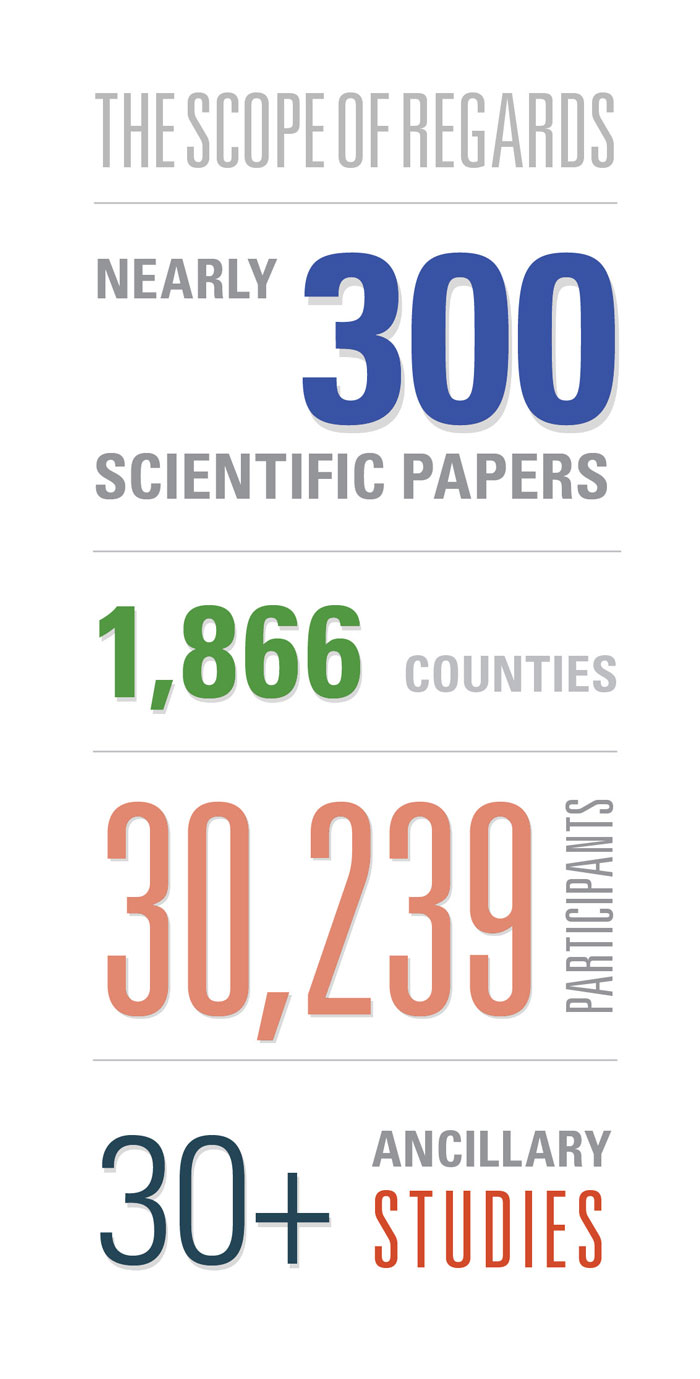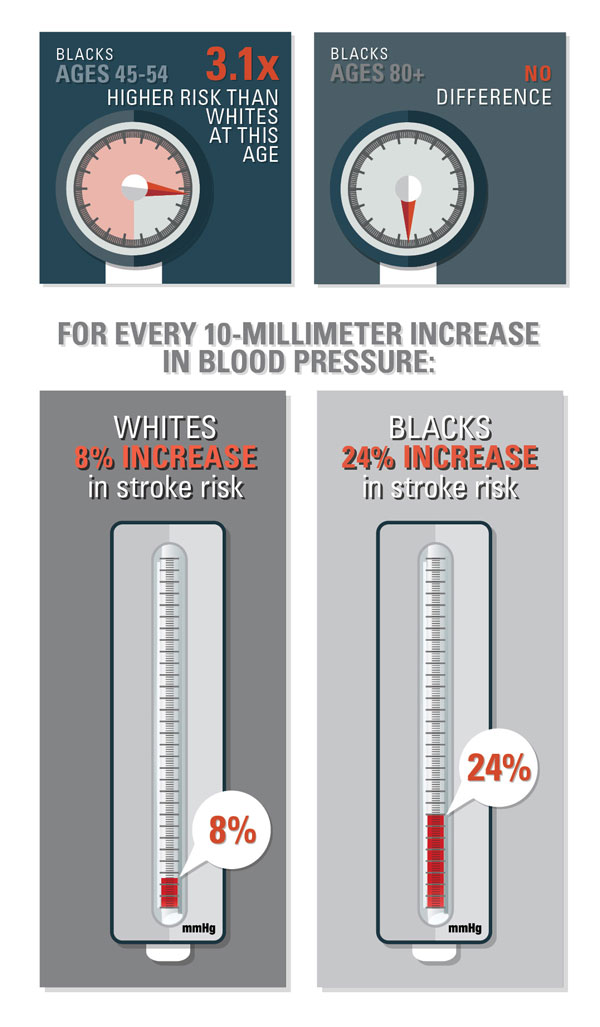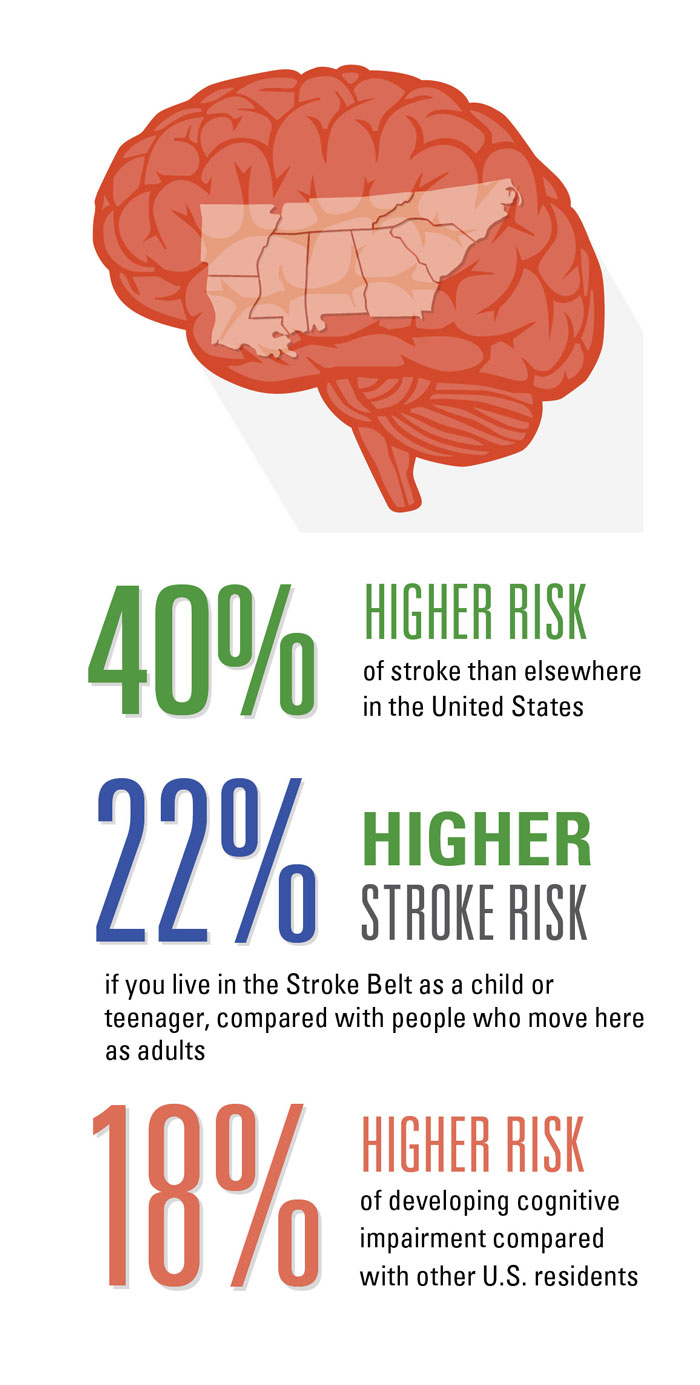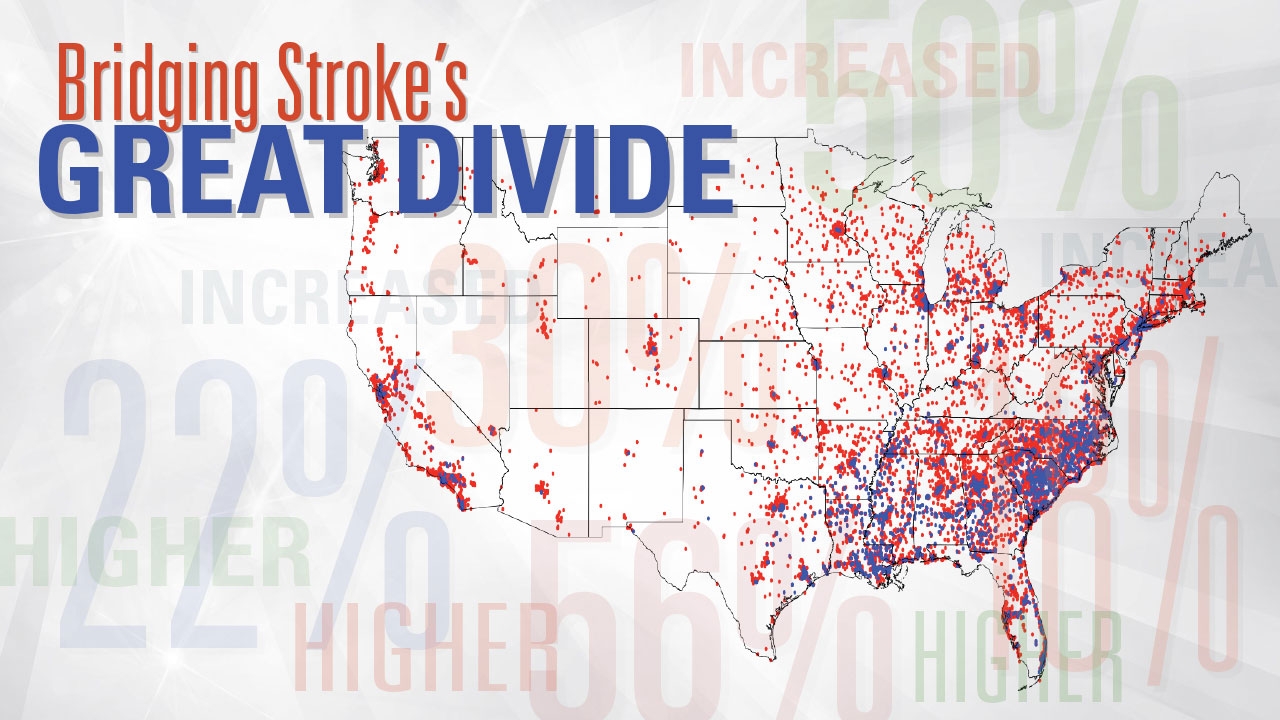REGARDS offers answers that could help save lives
By Charles Buchanan and Matt Windsor • Infographics by Laura Hannah
Scientists, physicians, and far too many families around here know the hard truths about stroke: Southerners have a 40 percent higher risk of dying from stroke than people in the rest of the country. And African-Americans below the age of 75 are at least two times more likely to die from stroke than whites.

To find out why, UAB School of Public Health researchers launched the REasons for Geographic and Racial Disparities in Stroke (REGARDS) study, the largest population-based study of its kind, in 2003. And in doing so, they revolutionized the way national studies are conducted. By partnering with health professionals who conduct in-home physicals for people purchasing life-insurance policies, REGARDS was able to collect detailed information—blood pressure, waist circumference, cholesterol levels, and much more—from people across the country. Follow-up interviews every six months have tracked changes in their health measures since then. To gather this kind of data in previous studies, researchers had to go to the expense of setting up clinics in multiple states.
The magnitude of REGARDS—funded by the National Institute of Neurological Disorders and Stroke—has been matched by the flow of findings out of it. UAB’s REGARDS team, including co-principal investigators (and spouses) George Howard, Dr.P.H., and Virginia Howard, Ph.D., professors of biostatistics and epidemiology, respectively; biostatistics associate professor Suzanne Judd, Ph.D.; epidemiology assistant professor Marguerite (Ryan) Irvin, Ph.D.; associate professor of gerontology, geriatrics, and palliative care Virginia Wadley Bradley, Ph.D.; and other researchers, has investigated stroke risk factors from multiple angles—everything from age and diet to where participants lived as children. Beyond UAB, hundreds of investigators have used REGARDS data for their own research. “As the study matures, it’s being recognized nationally as a unique resource to address a wide range of hypotheses,” says George Howard. “We are contributing to understanding why African-Americans and Southerners are at a higher risk for stroke, and we’re advancing a more general understanding of stroke and cognitive decline. But we’re also providing a platform for the study of a wide range of other health problems, from heart disease and kidney disease to sepsis and fractures.”
While REGARDS provides answers that could finally help close health gaps and save lives, Howard credits the 30,239 participants as the ongoing study’s “real heroes. They have been so gracious to let us into their homes and talk to them twice a year,” he says. “I don’t think they know the impact of their contributions, but every time I talk with them, I thank them.”
A glance at some of the study's surprising results:
 Younger African-Americans are more likely to have a stroke than whites, but that disparity diminishes with age. High blood pressure may help explain why. Even when receiving treatment, African-Americans are 30% less likely to have their blood pressure under control.
Younger African-Americans are more likely to have a stroke than whites, but that disparity diminishes with age. High blood pressure may help explain why. Even when receiving treatment, African-Americans are 30% less likely to have their blood pressure under control.
 Living in the Stroke Belt raises your risk. Why? Early childhood factors—such as lifestyle habits, education, and economic and environmental conditions—may have long-term consequences.
Living in the Stroke Belt raises your risk. Why? Early childhood factors—such as lifestyle habits, education, and economic and environmental conditions—may have long-term consequences.
 A Southern diet—high in processed meats, fried foods, and sugar-sweetened beverages—increases risk for stroke and other problems, and it doesn't matter if you're black, white, male, female, or whether you live in the South or not. A healthier diet of fruits, vegetables, beans, whole grains, lean chicken, and lean fish does the opposite.
A Southern diet—high in processed meats, fried foods, and sugar-sweetened beverages—increases risk for stroke and other problems, and it doesn't matter if you're black, white, male, female, or whether you live in the South or not. A healthier diet of fruits, vegetables, beans, whole grains, lean chicken, and lean fish does the opposite.
 Exposure to secondhand smoke increases stroke risk for nonsmokers by 30%, compared to those not exposed to secondhand smoke.
Exposure to secondhand smoke increases stroke risk for nonsmokers by 30%, compared to those not exposed to secondhand smoke.
 Areas in the South are not the fattest part of America after all. The West North Central states—North and South Dakota, Minnesota, Nebraska, Iowa, Kansas, and Missouri—have a 41% obese population while the East South Central region—Alabama, Mississippi, Tennessee, and Kentucky—is 34% obese.
Areas in the South are not the fattest part of America after all. The West North Central states—North and South Dakota, Minnesota, Nebraska, Iowa, Kansas, and Missouri—have a 41% obese population while the East South Central region—Alabama, Mississippi, Tennessee, and Kentucky—is 34% obese.
A Takeaway:
Approximately half the racial disparity in stroke risk can be attributed to traditional risk factors—such as high blood pressure and obesity—and socioeconomic factors, reported a 2011 UAB study. That gives physicians and policymakers a clear idea of how to make a major impact on reducing the gap through prevention and other measures.
Published April 2016

 Younger African-Americans are more likely to have a stroke than whites, but that disparity diminishes with age. High blood pressure may help explain why. Even when receiving treatment, African-Americans are 30% less likely to have their blood pressure under control.
Younger African-Americans are more likely to have a stroke than whites, but that disparity diminishes with age. High blood pressure may help explain why. Even when receiving treatment, African-Americans are 30% less likely to have their blood pressure under control. Living in the Stroke Belt raises your risk. Why? Early childhood factors—such as lifestyle habits, education, and economic and environmental conditions—may have long-term consequences.
Living in the Stroke Belt raises your risk. Why? Early childhood factors—such as lifestyle habits, education, and economic and environmental conditions—may have long-term consequences. A Southern diet—high in processed meats, fried foods, and sugar-sweetened beverages—increases risk for stroke and other problems, and it doesn't matter if you're black, white, male, female, or whether you live in the South or not. A healthier diet of fruits, vegetables, beans, whole grains, lean chicken, and lean fish does the opposite.
A Southern diet—high in processed meats, fried foods, and sugar-sweetened beverages—increases risk for stroke and other problems, and it doesn't matter if you're black, white, male, female, or whether you live in the South or not. A healthier diet of fruits, vegetables, beans, whole grains, lean chicken, and lean fish does the opposite. Exposure to secondhand smoke increases stroke risk for nonsmokers by 30%, compared to those not exposed to secondhand smoke.
Exposure to secondhand smoke increases stroke risk for nonsmokers by 30%, compared to those not exposed to secondhand smoke. Areas in the South are not the fattest part of America after all. The West North Central states—North and South Dakota, Minnesota, Nebraska, Iowa, Kansas, and Missouri—have a 41% obese population while the East South Central region—Alabama, Mississippi, Tennessee, and Kentucky—is 34% obese.
Areas in the South are not the fattest part of America after all. The West North Central states—North and South Dakota, Minnesota, Nebraska, Iowa, Kansas, and Missouri—have a 41% obese population while the East South Central region—Alabama, Mississippi, Tennessee, and Kentucky—is 34% obese.

